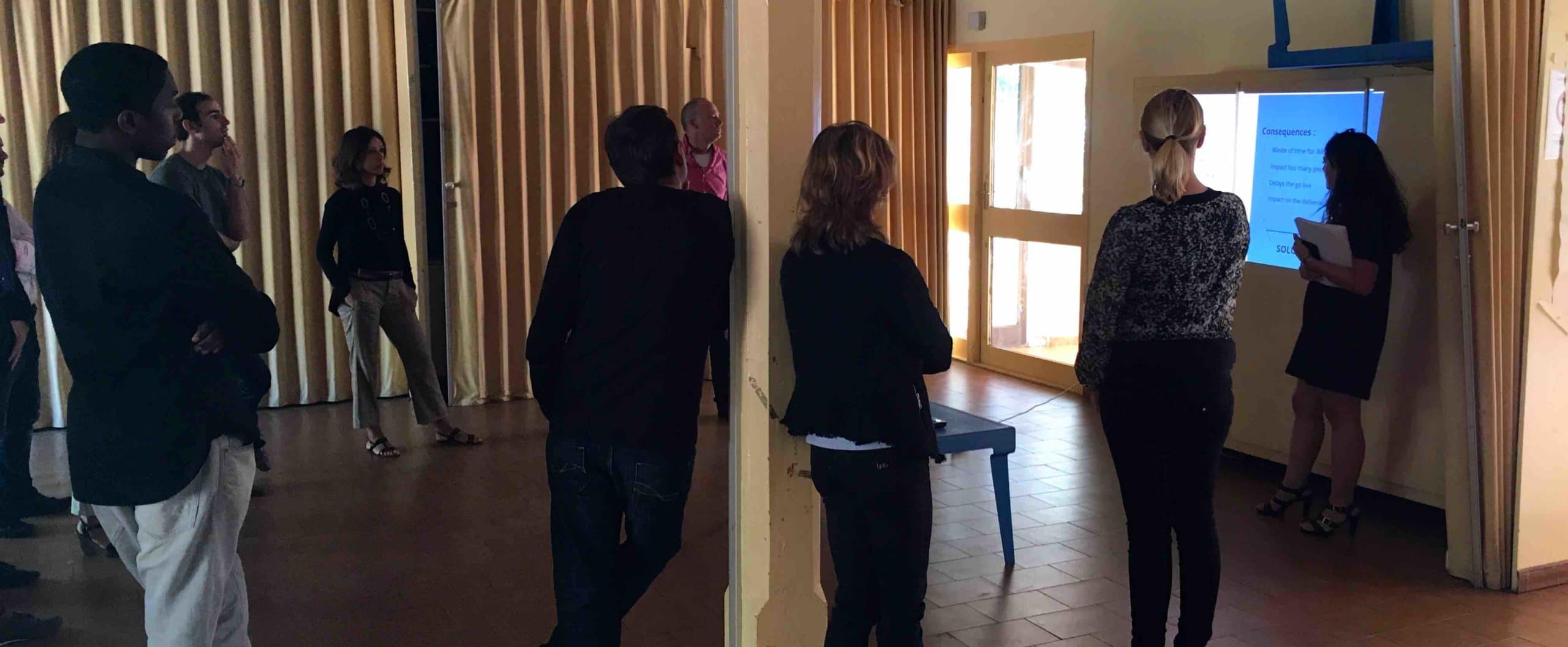
De retour sur l’équipe Kanban que j’accompagne en ce moment. Cette fois ci, c’est pour une rétrospective d’équipe en face to face que nous avons effectuée sur le thème de la communication. Je vous partage ici comme à chaque fois quelques éléments de contexte ainsi que des explications sur les ateliers mis en place.
Bonne lecture 🙂
Contexte

Petit rappel du contexte de l’équipe pour pouvoir re-situer un petit peu les événements.
Caractéristiques de l’équipe
- L’équipe se compose d’une trentaine de personnes distribuées sur 3 pôles : Business, AMO et IT
- Les pôles sont dispersés géographiquement sur Paris, Valbonne et Amsterdam
- La langue officielle de communication est l’anglais – qui n’est malheureusement pas toujours très bien maitrisé
Facilitateurs/Facilitatrices d’équipe
Nous avions initialement mis en place un système de double facilitateurs/facilitatrices au sein de chaque pôle :
- Un facilitateur global permettant de s’assurer de la cohérence de la chaîne de valeur globale, mais d’un point de vue local
- Un facilitateur local permettant de s’assurer du bon fonctionnement de l’équipe au sein du même pôle
L’idée fondamentale était d’avoir un point d’entrée privilégié pour le coach et que ces personnes aient la possibilité d’échanger ensemble plutôt que de se sentir isolées dans leur nouveau rôle. L’objectif étant de déléguer l’accompagnement au maximum pour autonomiser le plus rapidement possible.
Co-construction de la journée
L’accompagnement ayant débuté fin Mars, il était pour moi important de pouvoir donner la main au fur et à mesure à l’équipe pour qu’elle puisse entretenir cette « intention d’amélioration continue » qu’incarne Kanban elle-même par la suite. C’est d’ailleurs après une discussion avec un des facilitateurs par mail que nous en sommes arrivés à nous dire que le sujet de la communication pouvait être intéressant à traiter pendant le prochain événement en face à face.
J’ai alors profité de l’occasion pour demander si cela le tentait lui et les autres de prendre en charge une partie de cette journée : soit préparer, cadrer et animer un atelier d’environ 1h30. Mon rôle fut alors de construire un agenda cohérent autour de cet atelier et de leur assurer un filet de sécurité si besoin.
J’ai alors proposé aux facilitateurs/facilitatrices de co-construire ensemble leur atelier en itération, 30mn toutes les 2 semaines environ, avant la date de l’événement.
L’objectif étant de les habituer à collaborer dans ce genre d’exercice, de réfléchir à ce qui pourrait être le plus pertinent et qui apporterait le plus de valeur à l’équipe dans sa globalité maintenant.
Agenda

L’agenda de la journée était construit de la manière suivante :
- Introduction : présentation de la journée et inclusion des nouvelles têtes de l’équipe, tout particulièrement provenant de l’équipe Business
- Backlog Grooming : nettoyage du backlog stagnant depuis quelques mois par les decision makers.
- Communication Workshop : atelier d’amélioration continue focalisé sur la résolution de problématiques de communication – facilité par des membres de l’équipe
- Rétrospective : faire le point sur l’état de l’équipe et identifier les axes d’amélioration pertinents pour la suite
- System Efficiency : partie théorique pour rappeler la notion d’efficience du flux et redonner du sens aux éléments de mesure tels que le lead time et le touch time
- DoD / DoR : finaliser ce travail sur les règles du processus qui n’ont jamais véritablement été mis en place – nous n’avons finalement pas eu le temps de le faire ! :-/
- Daily Kanban Meeting : simulation avec l’équipe complète d’un Daily Kanban Meeting
Icebreaker : Numéro Secret

Pour démarrer, je voulais trouver une activité permettant d’introduire le thème de la communication et ainsi faire le lien avec l’atelier préparé par les facilitateurs/facilitatrices. Après avoir découvert le « numéro secret » animé par Régis Schneider lors du dernier Agile Playground auquel j’avais participé, je me suis dit qu’il ferait très bien l’affaire.
Voici en quoi il consiste.
Instructions
- Chacun des participants inscrit un nombre entre -∞ et +∞ sur un Post-it et le garde caché jusqu’à la fin de l’activité.
- L’objectif du groupe est de se réordonner physiquement du plus petit nombre au plus grand. Il est alors utile de montrer l’emplacement du plus petit et du plus grand ! 😉
- Mais tout cela n’aurait pas d’intérêt sans contraintes : les participants n’ont alors pas le droit de parler, d’écrire leur nombre ou de le mimer avec leurs doigts.
- Et bien évidemment, le résultat doit être obtenu sous 15 mn ! 😛
Déroulé
Le début de l’activité fut un peu chaotique : comment faire pour communiquer sans parler ? 😛
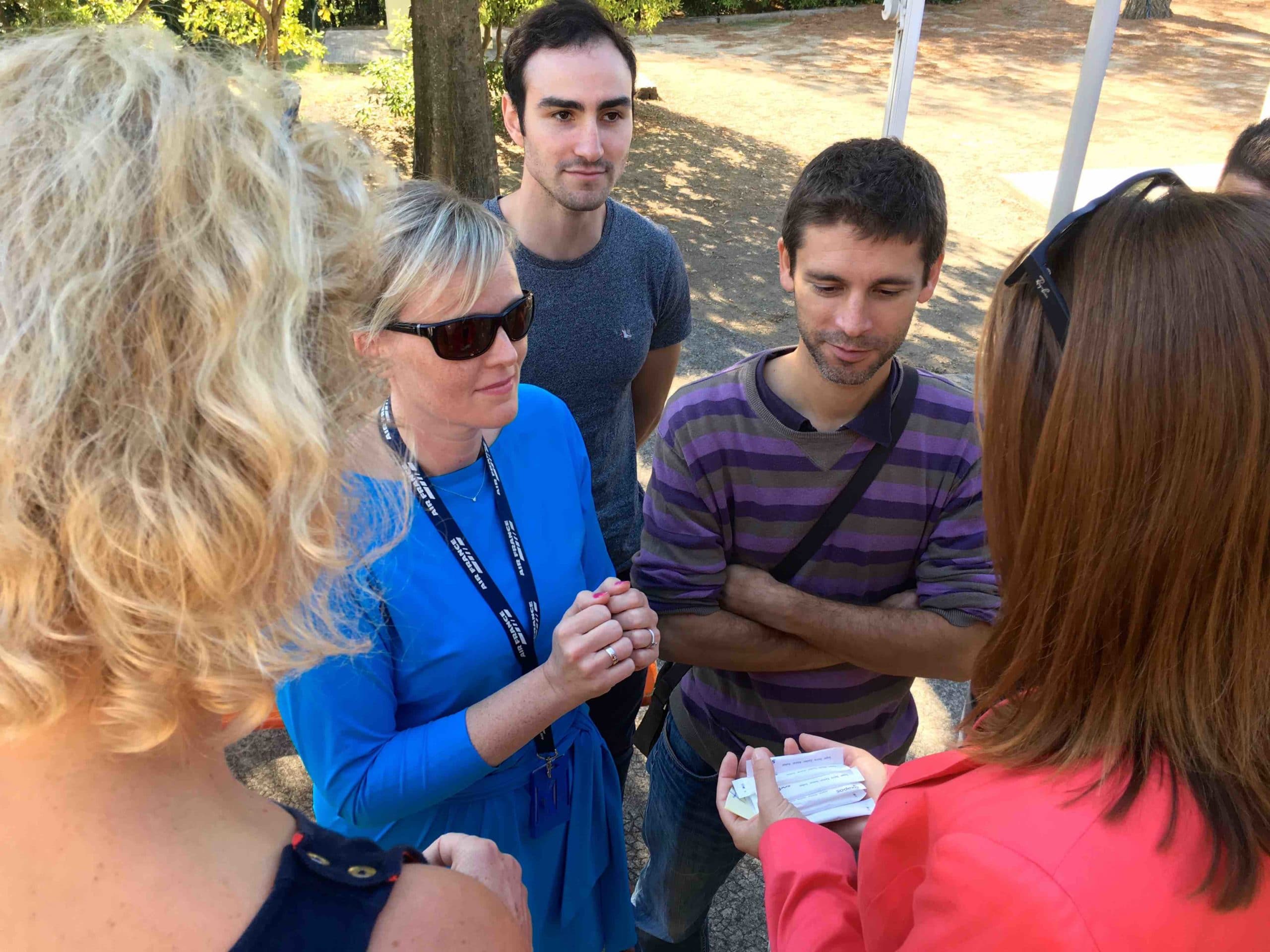
Puis de petits groupes se forment, se regardent, se sourient. Tout se déclenche lorsque certains commencent à taper des mains ou sauter à pieds joints ! L’ambiance devient plus joueuse, la créativité joue son rôle et l’on voit alors certains prendre ce qui leur passe sous la main pour tenter de communiquer : des sucrettes, des touillettes, des sachets de thé… tout est bon pour arriver à ses fins ! 😉
Après 15 mn d’activité, il était temps de lever le voile sur les nombres de chacun et vérifier l’ordonnancement final : seulement 3 erreurs sur plus d’une vingtaine de personnes !
Débriefing
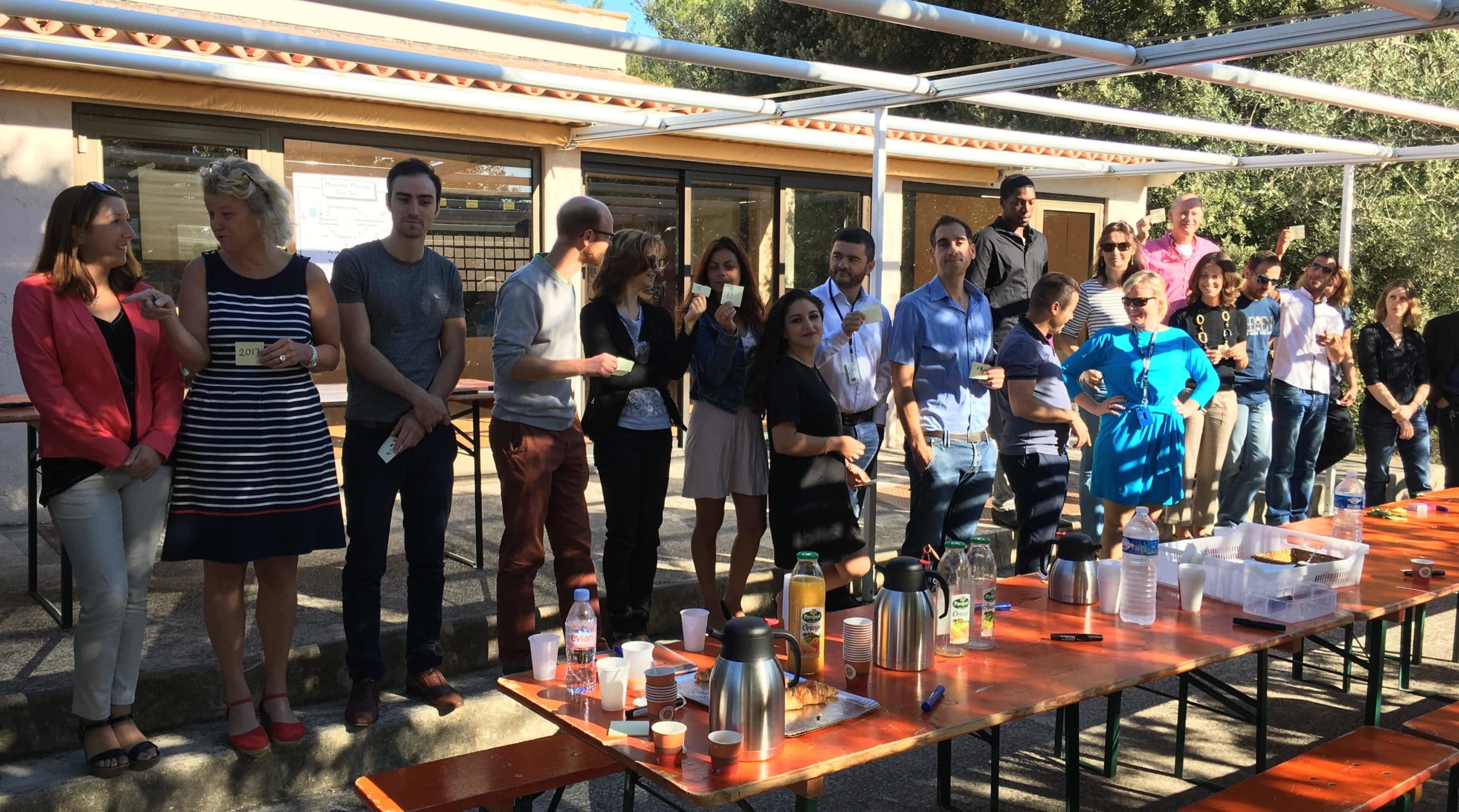
Après avoir félicité le groupe sur leur performance, le débriefing fut assez court.
Le message principal que je souhaitais faire passer était que la parole – ou autrement dit « les mots » – n’était qu’une manière de transmettre de l’information.
Il est alors intéressant de mettre en exergue que le principal outil de communication étant le mail, nous nous soumettons grandement à la mauvaise interprétation des messages et à une incompréhension entre personnes car nous ne nous basons que sur des mots écrits. Le constat est alors bien pire lorsque l’on écrit dans une langue qui n’est pas la nôtre ! 🙂
Backlog Grooming
L’idée de cet atelier m’est tout simplement venue en consultant le board (JIRA) numérique de l’équipe. En effet, d’un côté il y avait les tickets « standards » se déplaçant dans le flux de valeur et puis de l’autre, il y avait ceux stagnant dans la catégorie « Everything Else » – une petite centaine tout de même ! J’avais vu passer une série de mails demandant à l’un et à l’autre de jeter un oeil sur le paquet mais vu qu’il y a toujours des choses plus importantes à traiter, rien n’a véritablement été fait.
Je me suis alors dit que c’était la meilleure occasion pour l’équipe de nettoyer l’ensemble de ces demandes sachant qu’ils seraient réunis en face à face pour travailler.
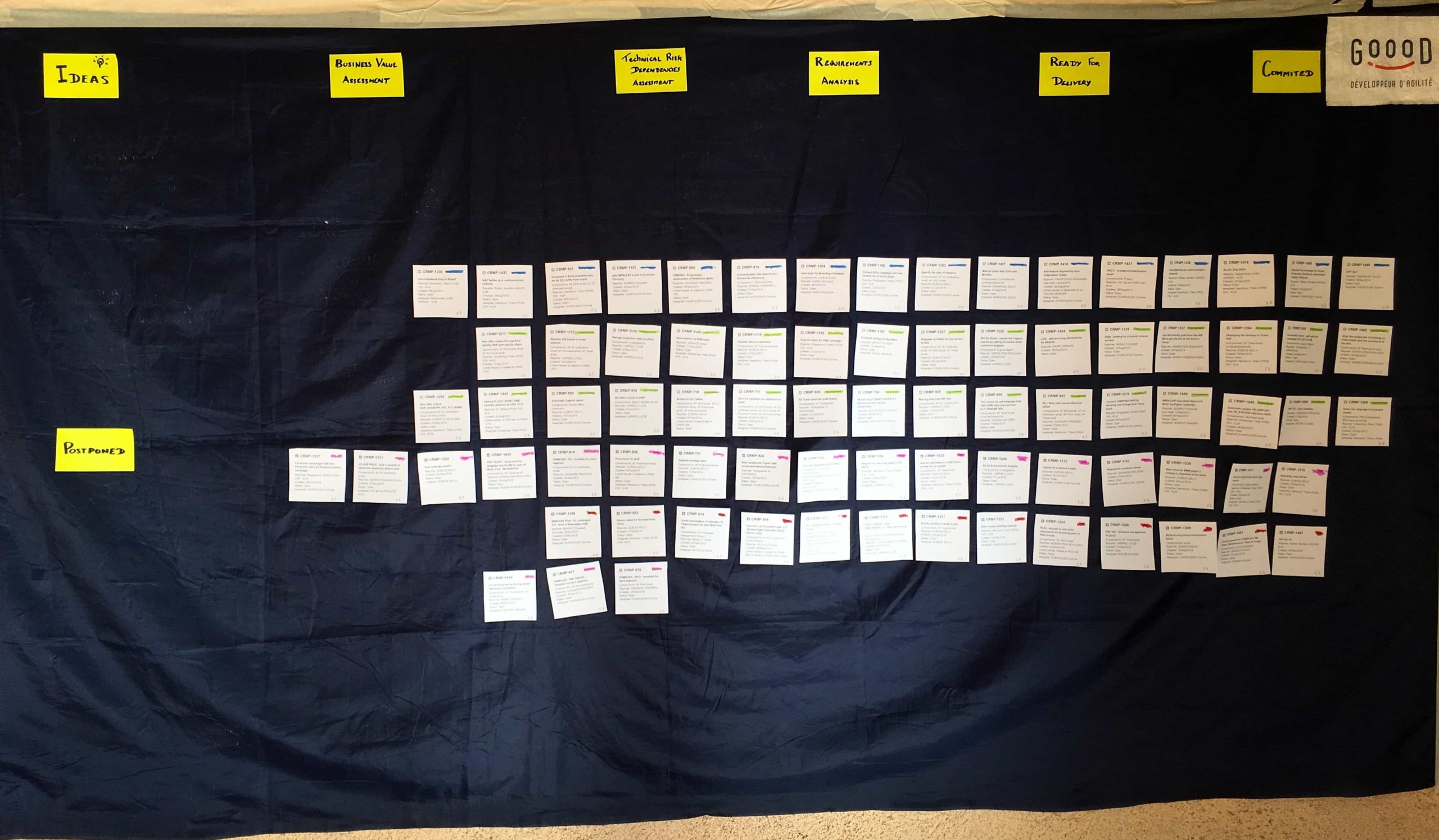
Aux grands maux les grands remèdes comme on dit, tous les tickets ont été imprimés et disposés sur un sticky wall. De plus, pour faciliter le repérage, j’ai passé un coup de marqueur de couleur pour distinguer les différentes typologies de tickets.
Pour accélérer au maximum le processus, j’ai seulement demandé aux personnes à même de prendre des décisions (les managers donc) de participer à cet atelier.
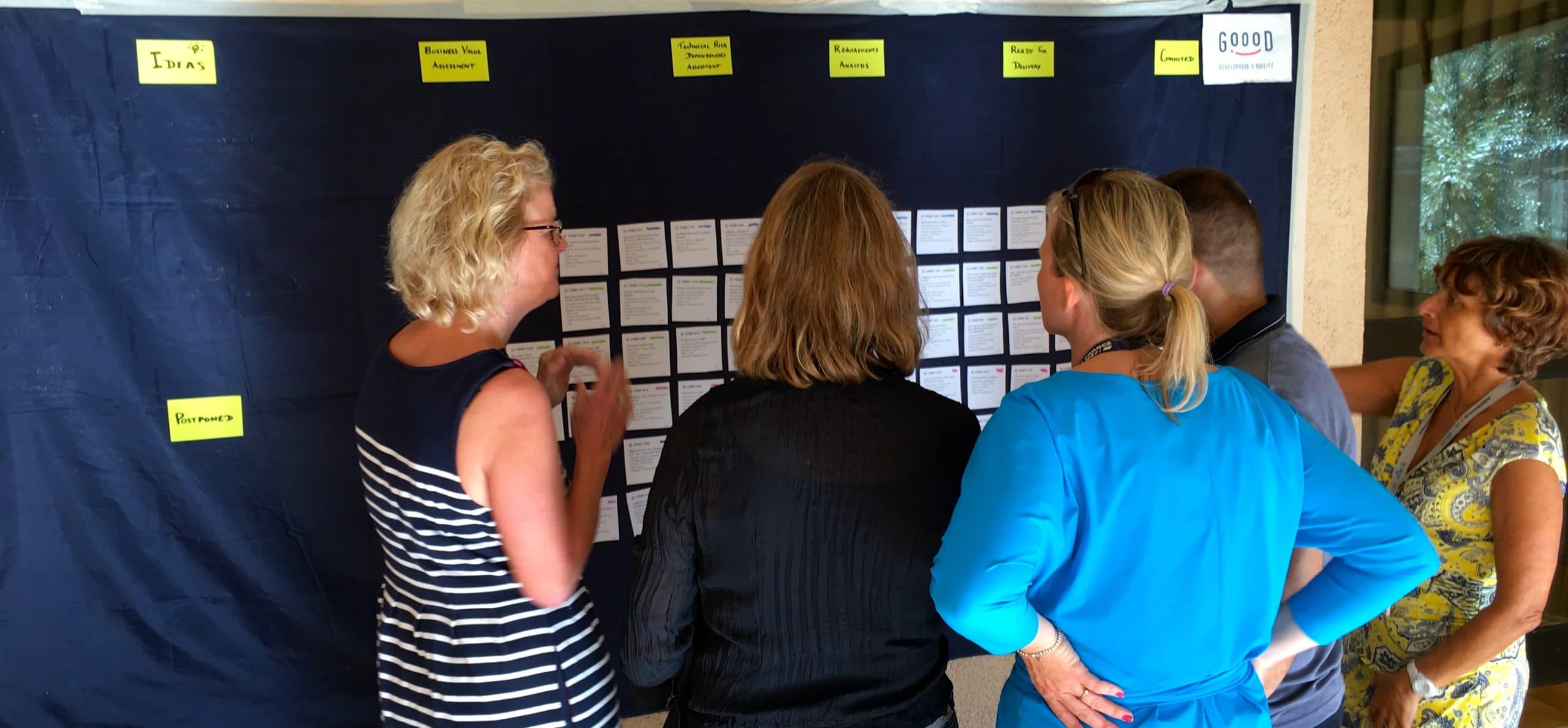
En effet, le workshop de communication sera fait en parallèle avec le reste de l’équipe. Ce fut d’ailleurs un autre élément de motivation : je leur ai indiqué que plus vite ils termineront ici, plus vite ils pourront rejoindre les autres ! :-p
L’objectif était donc de distribuer l’ensemble des tickets sur les colonnes de bases d’un Discovery Board Kanban :
- Ideas : les idées provenant du business. C’est le stock initial de demandes entrantes, à étudier.
- Business Value Assessment : quelle valeur métier apporte cette nouvelle idée ? L’étude de la valeur doit être effectuée.
- Technical risk and Dependencies Assessment : quels sont les risques techniques et les dépendances identifiées ? L’analyse technique doit être effectuée.
- Requirement Analysis : après l’évaluation de la valeur métier et des risques techniques, éventuellement d’une première priorisation, c’est la rédaction des spécifications qui doit être effectuée.
- Ready for Delivery : les éléments présents dans cette colonne ont tout ce qu’il faut pour être pris en charge par l’équipe Delivery.
- Committed : parmi les éléments prêts, voici ceux que nous nous engageons à prendre en charge pendant la prochaine cadence de Delivery.
- Postponed : nous n’avons pas toutes les informations pour pouvoir décider de l’emplacement de cet élément mais nous ne voulons pas le jeter. Il est donc remis à plus tard.
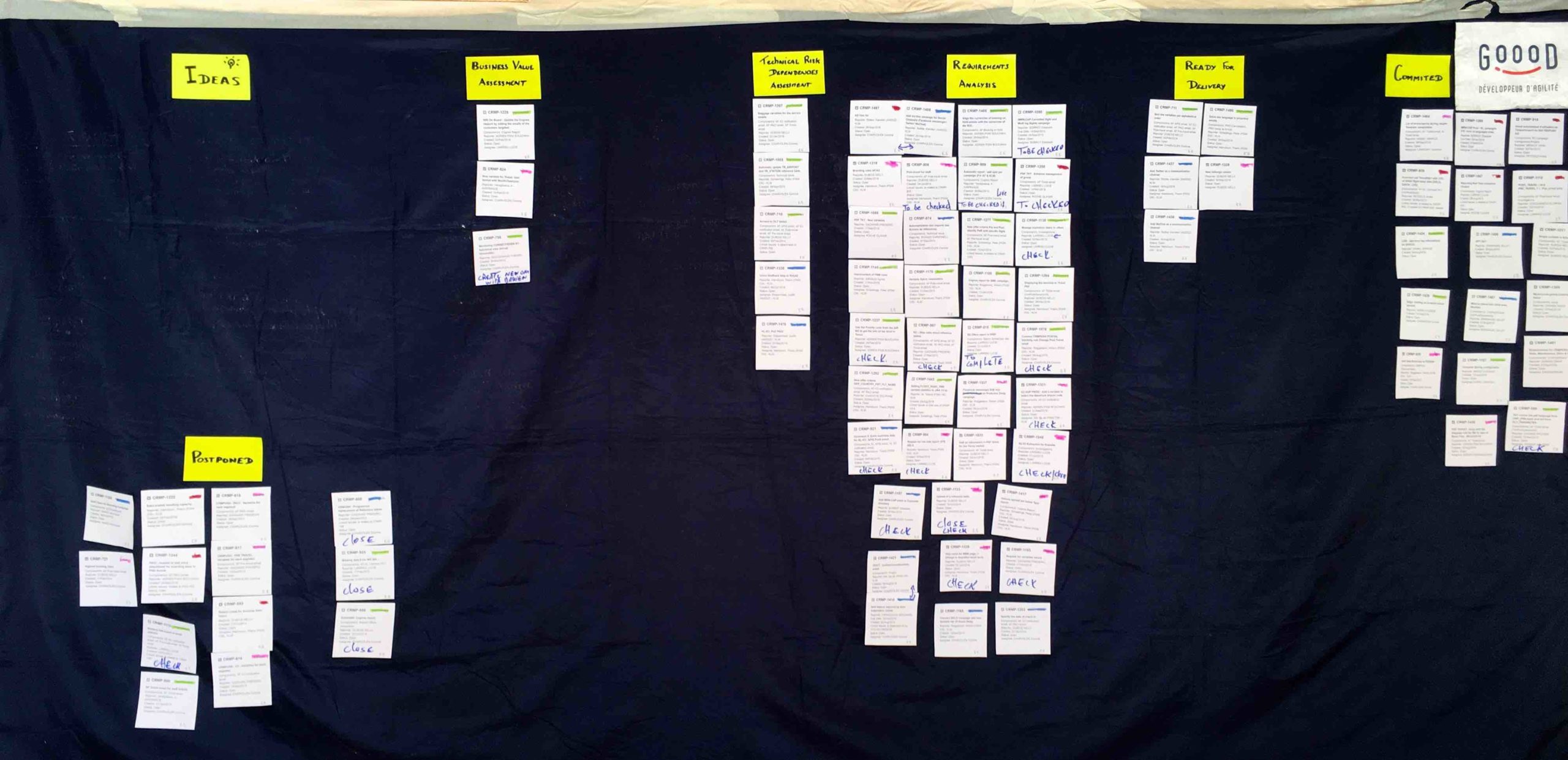
Après 45 mn d’échanges et de discussions, voilà près de 90 tickets distribués dans les différentes colonnes ! La puissance du management visuel physique en action n’est-ce pas ? 🙂
En plus d’une visibilité plus claire sur le positionnement des différents tickets, ce travail a permis d’identifier un certain nombre de doublons probablement créés par mégarde.
Maintenant, au vu du résultat obtenu, quelques questions se sont naturellement posées :
- Il y a beaucoup de tickets en Requirement Analysis. Avez-vous la capacité pour traiter tous ces éléments ? Pouvez-vous prioriser ces demandes ?
- Il y a également beaucoup d’éléments en Commited. Êtes-vous sûr de pouvoir satisfaire vos engagements aujourd’hui ?
Communication Workshop
L’objet de cet atelier était donc de traiter quelques situations problématiques de communication rencontrées par l’équipe et de trouver des solutions à expérimenter. Et tout cela, sans moi ! 🙂
Voici comment ils ont procédé.
Présentation des cas d’étude
Dans cette première phase, une introduction théorique sur les modes de communication a été effectuée permettant plus facilement d’introduire 3 cas identifiés comme étant des problématiques de communication à traiter par l’équipe.
Ces 3 cas avaient été au préalable préparés et priorisés à partir d’une liste bien plus fournie. Maintenant, j’ai insisté sur le fait que l’on préfèrait la qualité à la quantité et qu’à force de vouloir tout traiter en même temps, on ne traite finalement rien du tout ! 🙂
Étude en sous-groupes des cas
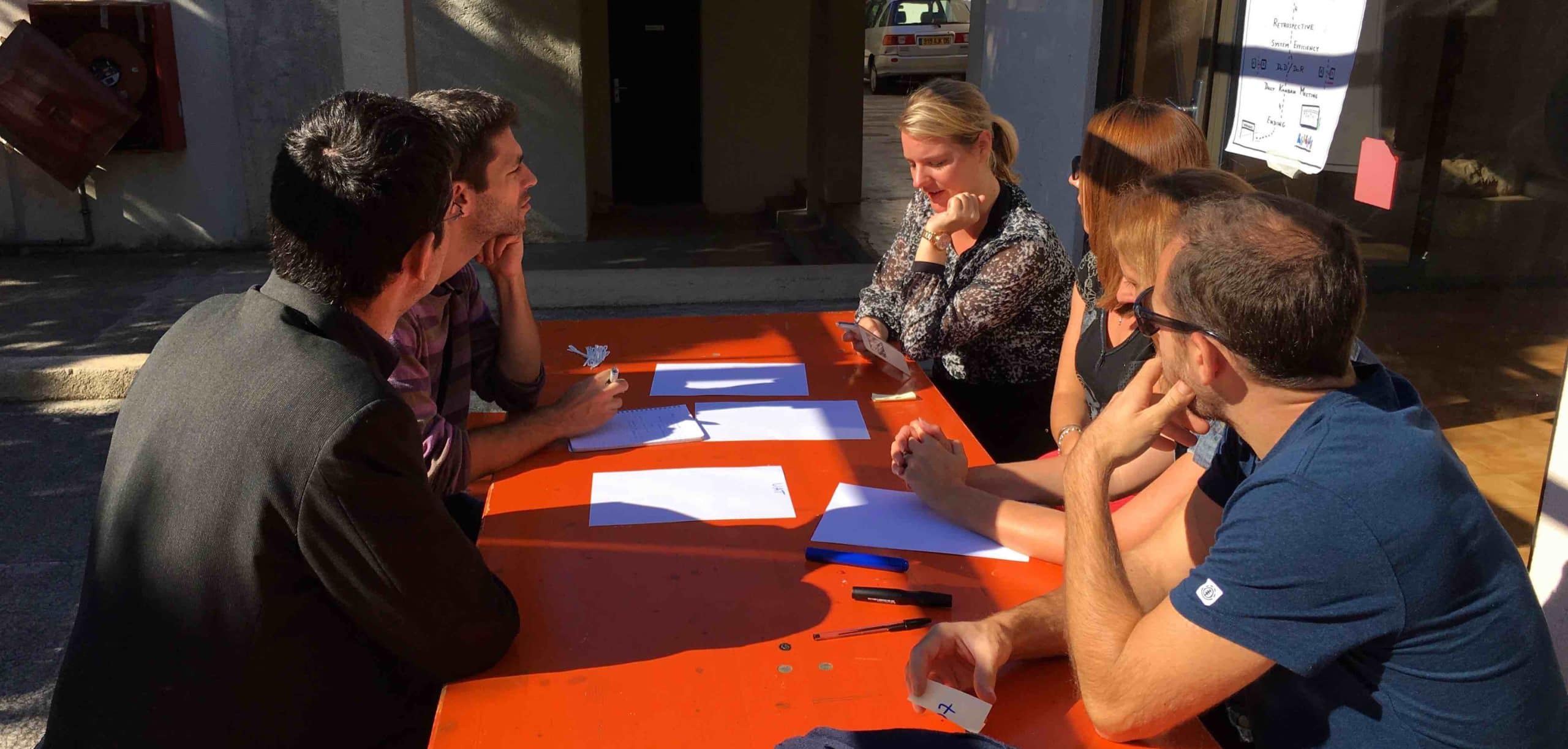
Chaque sous-groupe avait été défini à l’avance par souci de temps et surtout pour assurer une diversité des profils (Business, AMO, IT). L’objectif de chaque sous-groupe était de déterminer une piste de solution pour chacun des 3 cas évoqués précédemment.
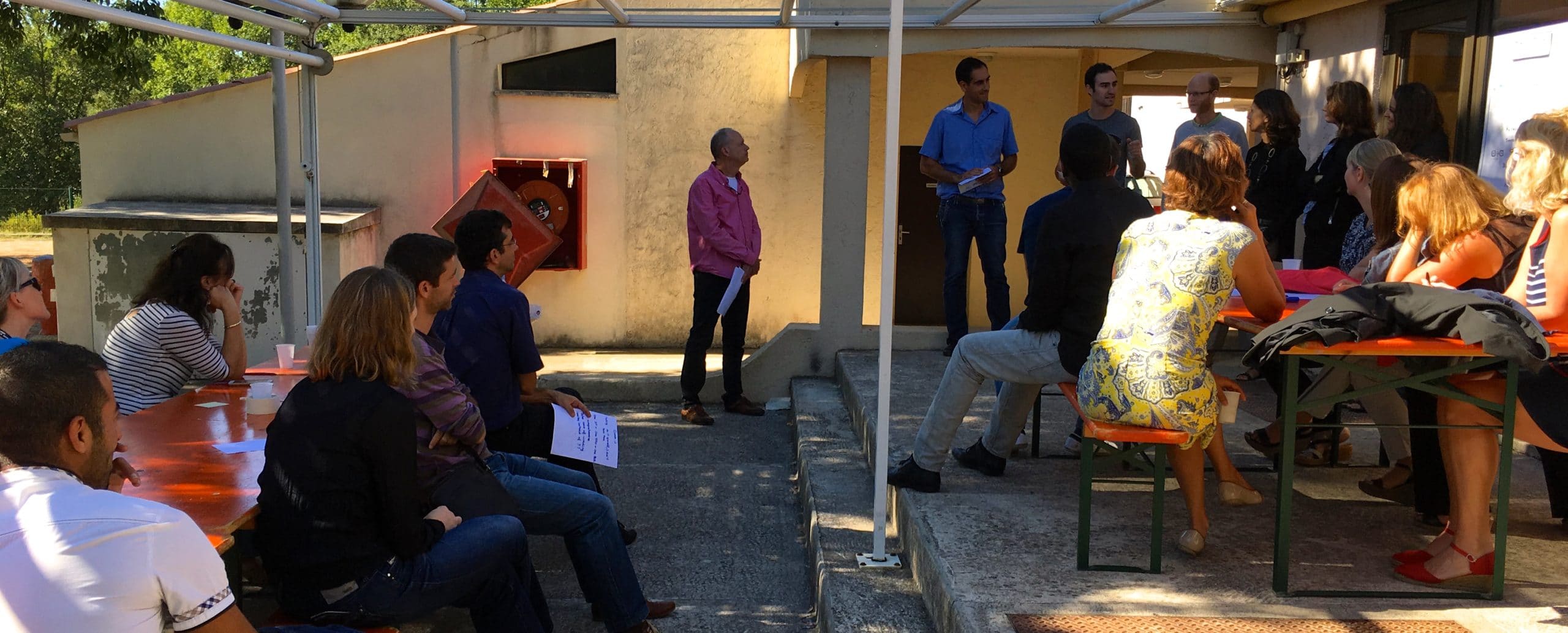
Chaque sous-groupe a ensuite présenté ses résultats à l’ensemble.
Votes sur les expérimentations à mettre en oeuvre
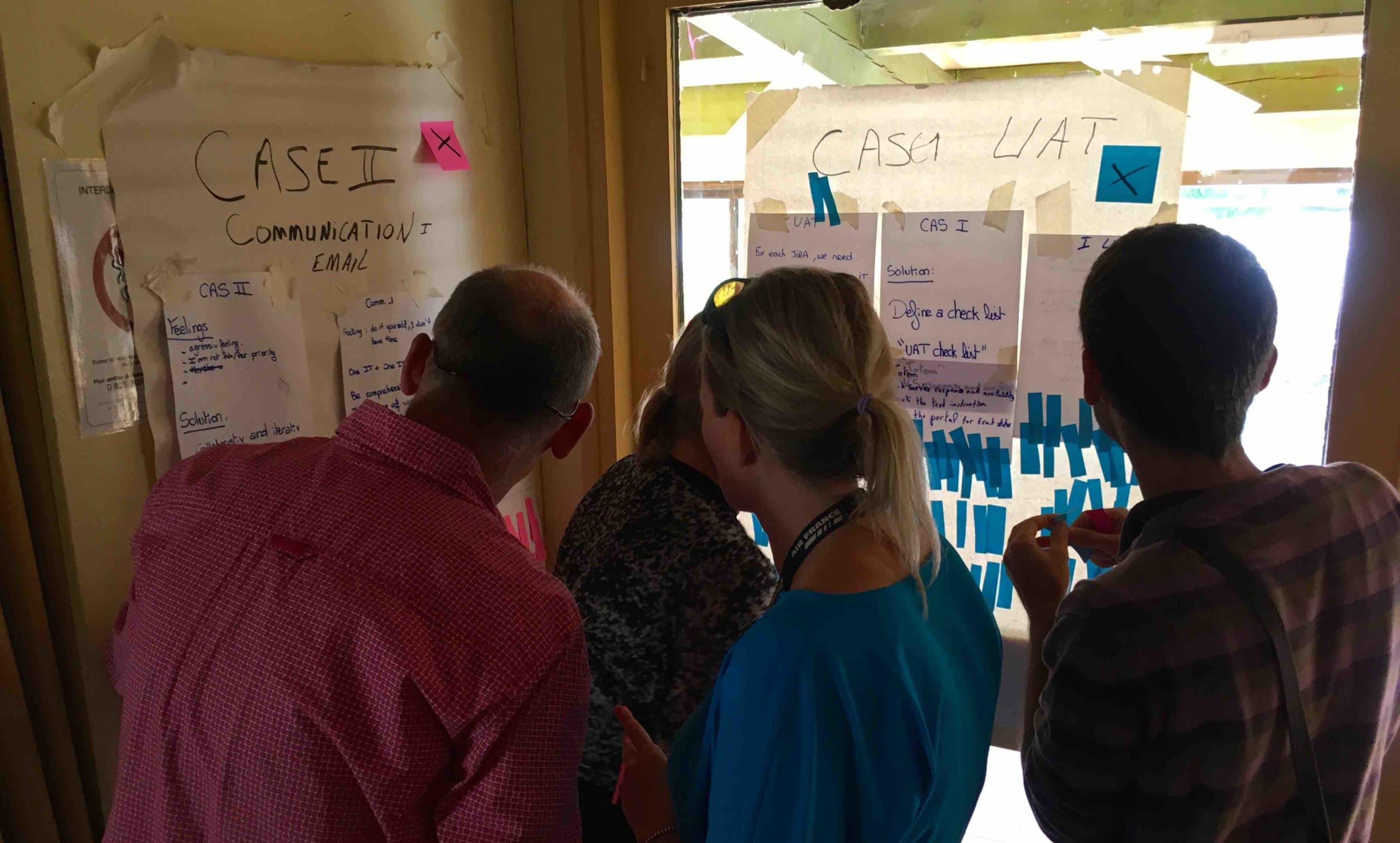
Un certain nombre de points a donc été donné aux participants sous forme de lamelles de Post-it. Chacun est allé voter sur ses solutions préférées, sous-entendu celles qui lui paraissent les plus pertinentes à mettre en place maintenant.
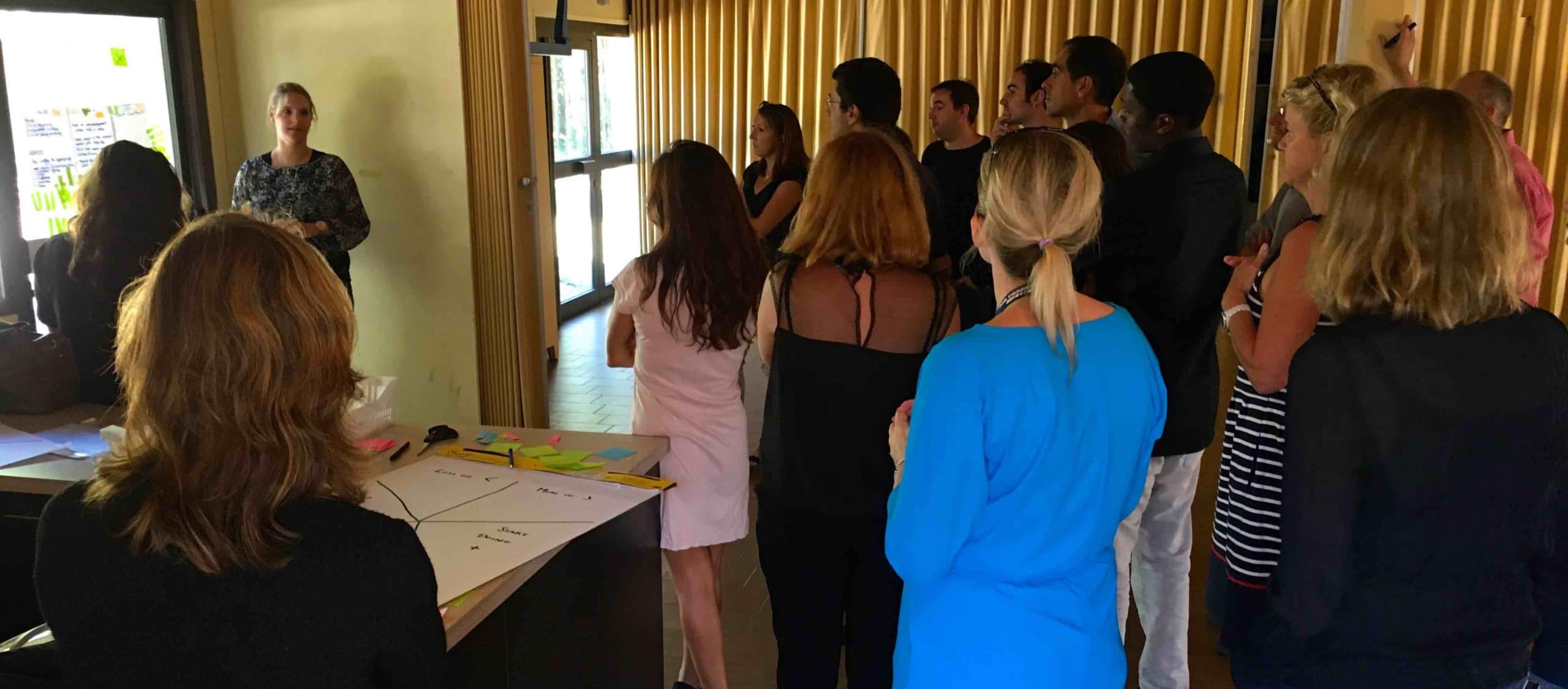
Après avoir comptabilisé tous les votes, ce fut le débriefing général effectué avec brio par les facilitateurs/facilitatrices. Et tout cela en respectant le temps imparti des 1h30. Bravo à eux ! 🙂
Energizer : Movers and Shapers
J’avais découvert l’activité Movers and Shapers par le biais de l’article de Tobias Mayer à ce sujet et j’ai trouvé que cela correspondrait très bien aux messages que j’aurais aimé faire passer à l’équipe. En effet, c’est un exercice permettant de montrer l’impact systémique d’un individu sur la dynamique d’équipe. C’était alors une bonne occasion de le mettre en pratique.
C’est une activité qui se déroule en 3 tours où l’on va demander aux participants de se déplacer / positionner entre eux selon certains critères, et tout cela dans le silence !
Tour 1 : Se mettre entre 2 personnes
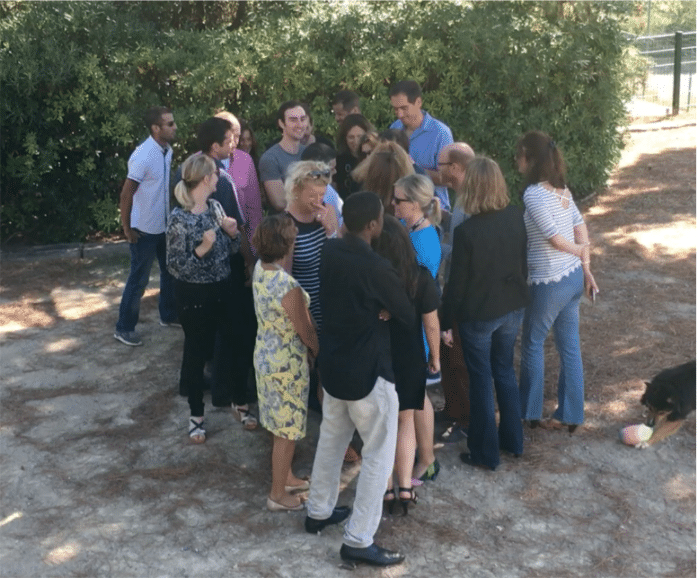
Instruction : Chacun doit choisir silencieusement 2 personnes du groupe et toujours rester entre ces 2 personnes.
Observation : le groupe se resserre sur lui-même, tellement que certaines personnes n’arrivent plus à se positionner comme elles le souhaiteraient.
Débriefing : ce tour a pour titre « Protecteur » dans l’article de Tobias Mayer. Protecteur dans le sens où l’on protège quelqu’un de quelqu’un ou quelque chose en se positionnant entre les deux. Il décrit cela comme une dynamique où chacun couvre les erreurs des autres. On pourrait dire que cela renforce les liens de l’équipe.
Tour 2 : Se cacher d’une personne derrière une autre
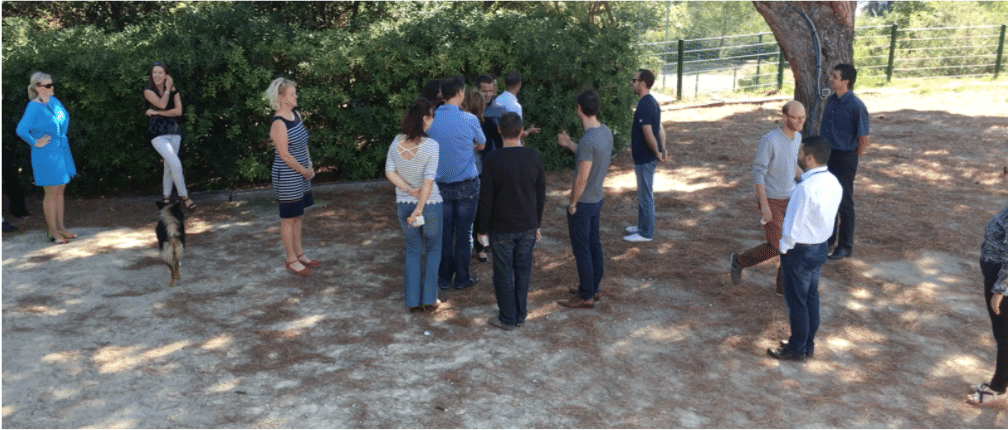
Instruction : Chacun doit choisir silencieusement 2 personnes du groupe et se cacher de l’une, derrière l’autre.
Observation : le groupe bouge beaucoup, la dynamique est plus rapide, comme une machine qui s’emballe. On peut voir des gens qui se courent après et surtout, on voit le groupe qui s’étend de plus en plus sur la surface disponible.
Débriefing : ce tour a pour titre « Victime » dans l’article de Tobias Mayer. La dynamique de groupe est dans le blâme et l’évitement. Plus on évite nos problèmes en blâmant les autres, plus on impacte la dynamique de l’équipe qui va avoir tendance à s’éclater.
Tour 3 : Former un triangle équilatéral
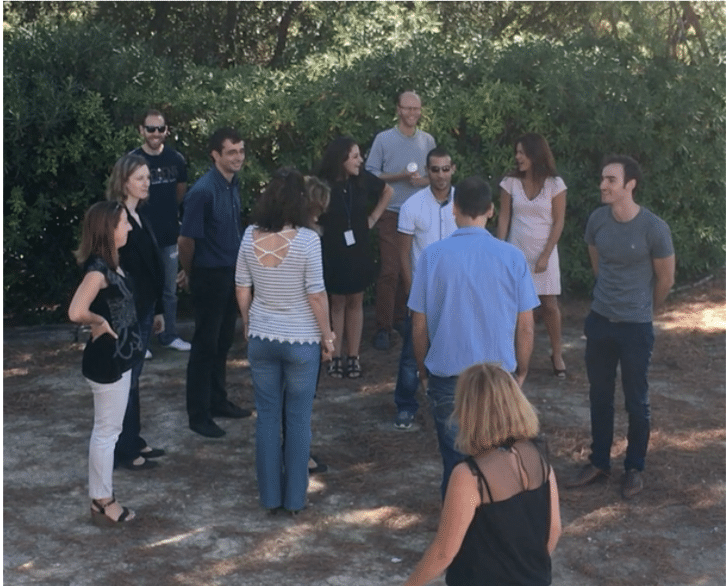
Instruction : Chacun doit choisir silencieusement 2 personnes du groupe et former avec elles un triangle équilatéral.
Observation : Le rythme du groupe est plus « soutenable », les gens se placent et s’observent. Des partenariats implicitent se créent. Le groupe reste en mouvement même si ce mouvement est plus léger.
Débriefing : ce tour a pour titre « Égalitaire » dans l’article de Tobias Mayer. La dynamique de groupe est dans le partage de l’espace collectif, respectueux de l’espace individuel de chacun. Le groupe est toujours dans un léger mouvement, typique d’un système vivant.
Rétrospective : Starfish

Le Starfish fait partie des formats de rétrospectives les plus communs que j’ai pu voir jusqu’à aujourd’hui, maintenant cela ne lui enlève en rien de son intérêt ! 😉
En effet, c’est un format simple et rapide avec sa petite touche de nuances à la différence d’un format standard en 3 phases. Voici un petit rappel du mode de fonctionnement.
Chaque participant réfléchit selon les 5 thèmes suivants :
- More of (>) : quelles sont les choses que l’on fait aujourd’hui et dont on bénéficierait de faire encore plus souvent ?
- Less of (<) : quelles sont les choses que l’on fait aujourd’hui et dont on bénéficierait de faire moins souvent ?
- Keep doing (=) : quelles sont les choses que l’on fait aujourd’hui et que l’on devrait continuer à faire de cette manière ?
- Stop doing (-) : quelles sont les choses que l’on fait aujourd’hui et dont on bénéficierait de ne plus du tout faire ?
- Start doing (+) : quelles sont les choses que l’on ne fait pas aujourd’hui et dont on bénéficierait de commencer à faire ?
Pour accélérer la restitution, chacun est venu coller ses Post-it (maximum 3) dès qu’il ou elle avait terminé. Je suis passé par chaque thème et par chaque post-it en demandant des précisions si nécessaire pour l’ensemble du groupe. L’idée étant de ne pas rentrer dans les détails précis de l’élément mais d’en assurer une compréhension collective partagée.
Nous avons ensuite procédé à un Dot Voting pour déterminer le Top 3 des éléments à traiter pour la prochaine cadence.
Efficience de système
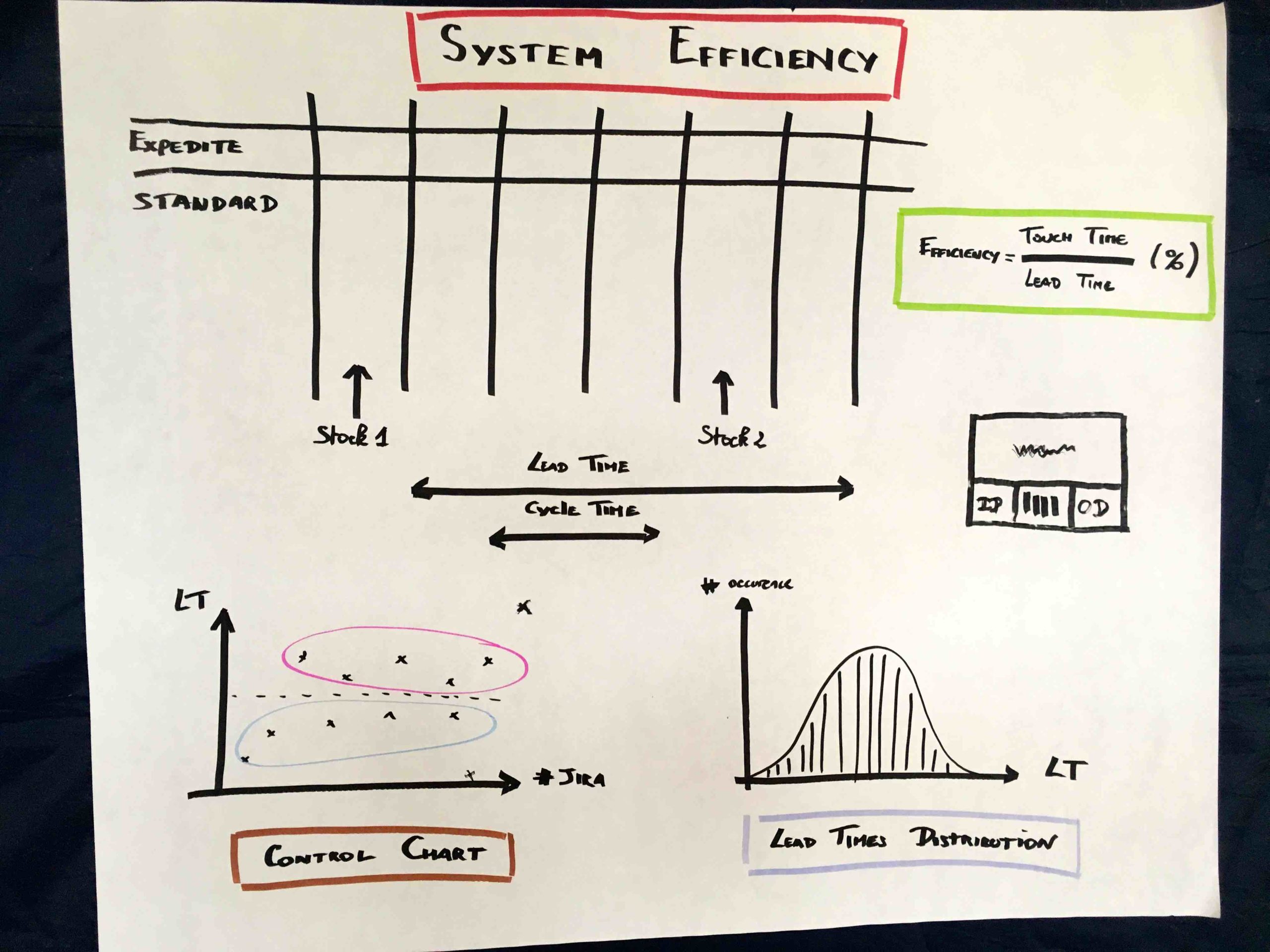
Ce moment fut la partie théorique de la journée. Une manière pour les participants de pouvoir se reposer un petit peu ! 😉
De plus, l’ensemble de l’équipe étant réunie, c’était une bonne occasion de resynchroniser les connaissances de chacun pour aller dans la même direction.
Les sujets évoqués furent les suivants :
- Une structure Kanban basique avec 2 lignes de priorité : ici on voit les classes de service Expedite et Standard.
- La notion de double stocks pour le delivery board : le premier stock correspond à l’ensemble des demandes que l’on a acceptées de prendre en compte, résultant de toute la phase de knowledge-discovery effectuée par le Discovery board. Le second stock correspond à l’ensemble des demandes que l’on considère prêtes à être livrées.
- Les mesures de Lead Time et Cycle Time : temps que prend un élément de l’entrée à la sortie d’un système (Lead Time) ou d’un sous-système (Cycle Time).
- La carte de contrôle : regroupant l’ensemble des Lead Times des demandes. Elle permet d’observer la différence dans les temps de traitement et éventuellement d’identifier des regroupements de demandes ainsi que leur temps moyen de traitement.
- La distribution des Lead Times : correspond à un spectre de la carte de contrôle et permet notamment de pouvoir obtenir une prévision de la capacité à faire du système.
- La mesure de l’efficience du système : nombre structurant permettant de définir l’état actuel de leur système. Elle correspond au ratio du Touch Time (temps effectivement passé à traiter une demande) sur le Lead Time (temps entre l’entrée et la sortie de la demande) et indique ainsi par inversion le temps d’attente d’une demande dans le système. Si le nombre est bas, on peut alors considérer que la taille des éléments de travail a moins d’impact sur le temps de traitement que la réduction des délais d’attente dans le système. De plus, comme base de référence, David J. Anderson mentionne le fait qu’une efficience > 15% est normale et > 40% est bonne.
L’objectif étant de sensibiliser l’équipe aux éléments de mesure, point souvent mis de côté par beaucoup d’implémentations Kanban.
Daily Kanban Meeting
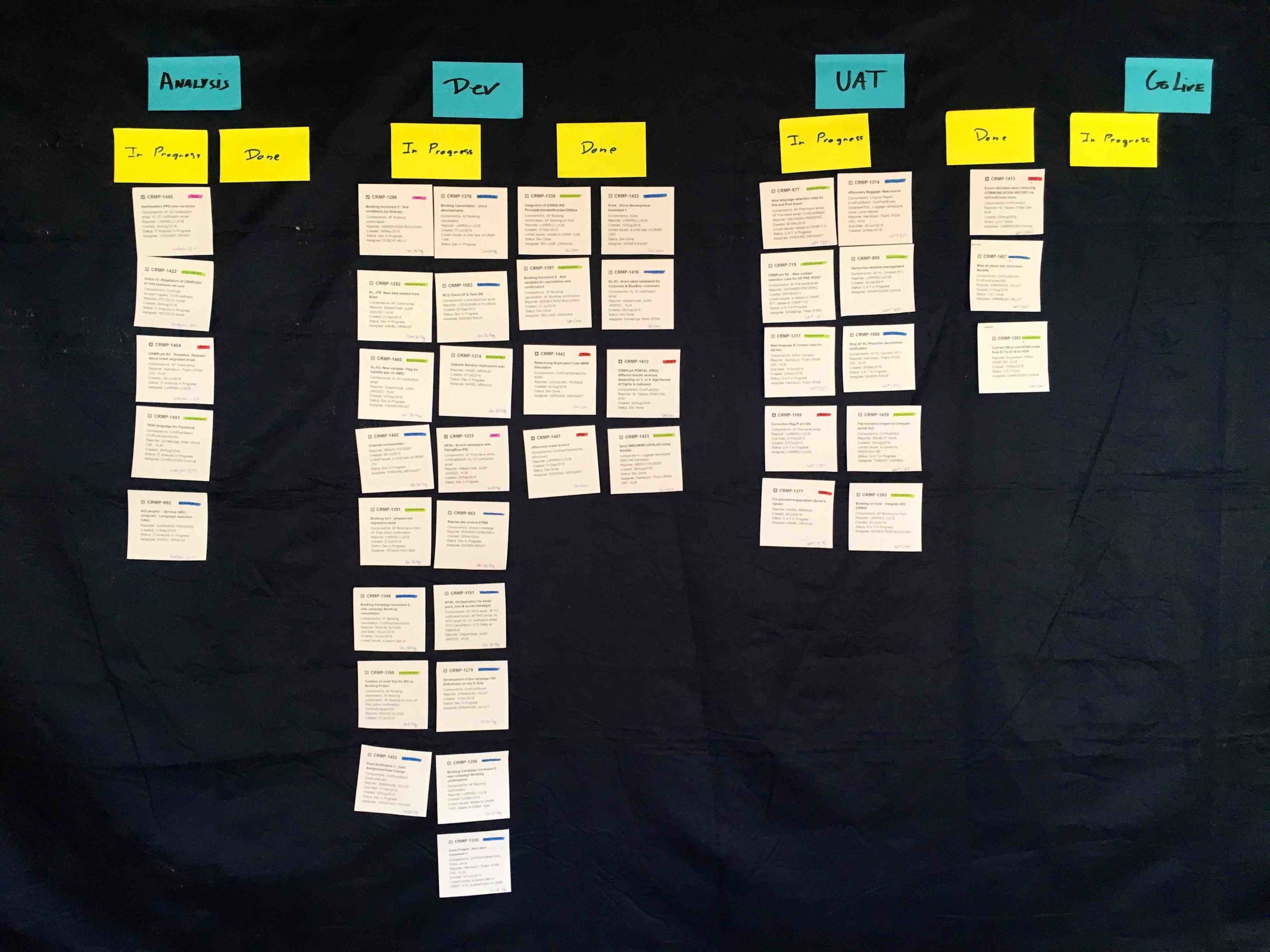
L’objectif de cette partie était de simuler un Daily Kanban Meeting avec l’ensemble de l’équipe. En effet, le fait d’avoir toutes les parties réunies en présentiel était pour moi la meilleure configuration pour préparer les éventuels meetings futurs !
Une nouvelle fois, on ne lésine pas sur les moyens, tous les tickets actuels ont été imprimés et replacés sur un sticky wall pour reconstruire physiquement ce qui existait numériquement.
J’ai ensuite déroulé un protocole type de Daily Meeting Kanban (orienté flux donc) :
- Le tableau est-il à jour ?
- Y a t-il des éléments urgents à remonter ?
- Y a t-il des éléments de blocages à traiter ?
- Que vous manque t’-il pour faire avancer vos éléments de travail vers la sortie ?
- Avez-vous besoin d’aide ?
- Etc…
et tout cela en parcourant le tableau de la droite vers la gauche ! 🙂
Conclusion
Ce workshop a été pour moi une expérience très enrichissante car j’ai eu la possibilité d’inclure des personnes de l’équipe dans l’organisation de la journée. Nous avons ainsi pu travailler en équipe pour élaborer ce qui semblait être le plus pertinent pour eux à ce moment là. Mon travail fut alors de les accompagner au mieux et de rendre le programme global le plus cohérent possible.
Enfin, je suis particulièrement content d’avoir pu intégrer et animer les ateliers « Nombre Secret » et « Movers and Shapers » que j’avais depuis longtemps envie de tester. Je les trouve forts en apprentissage et plutôt simples à animer. Je peux ainsi après coup vous les recommander chaudement ! 🙂

